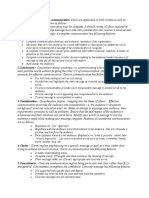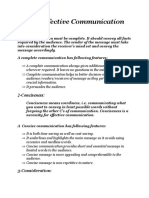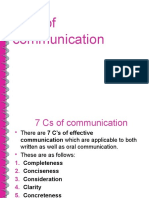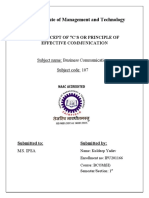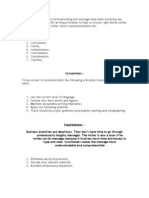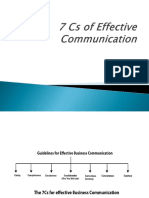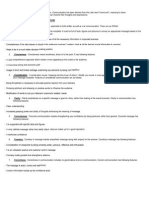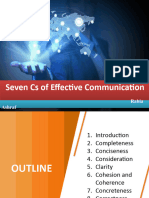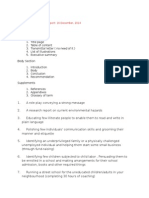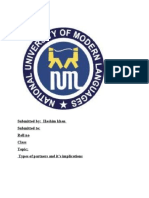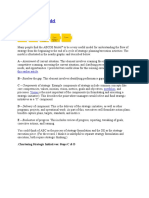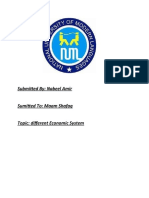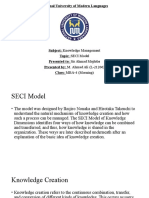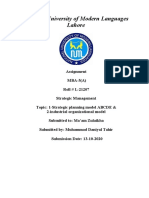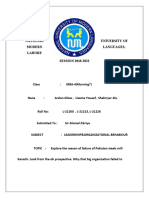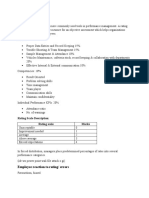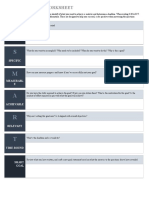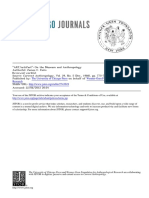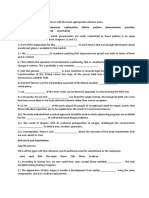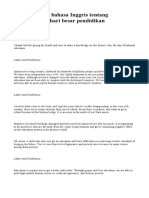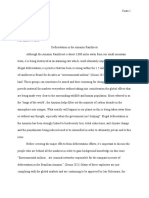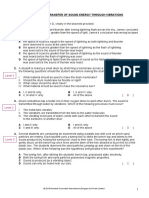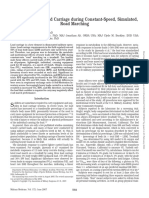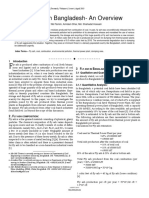Assignment#01
Subject: Business Communication and Report Writing
Topic: 7C’c of Effective Communication
Submitted to: Ma’am Halima
Submitted by: Anam (1604)
Class: BBA-2nd
Page 1 of 5
�What is Communication?
Communication is the process of sending and receiving messages through verbal or nonverbal
means, including speech, or oral communication; writing and graphical representations (such as
infographics, maps, and charts); and signs, signals, and behavior. More simply, communication
is said to be "the creation and exchange of meaning."
What are the 7 C’s of Communication?
We communicate all day long; at home, at work, with our next-door neighbor and at the sports
club. We communicate verbally, non-verbally and in writing. Unfortunately, the message does
not always come across as intended. NOISE! This can lead to miscommunication and (small)
misunderstanding or the wrong impression.
The 7 C’s of communication, also known as the 7 principles of communication are a useful way
to ensure good and business communication. The 7C’s of Communication provide a useful check
list as a result of which both written and verbal communication pass off in a clear, plain, target
group-oriented and well-structured manner.
There are 7 C’s of effective communication which are applicable to both written as well as oral
communication. These are as follows:
1. Completeness
2. Concreteness
3. Courtesy
4. Correctness
5. Clarity
6. Consideration
7. Conciseness
Page 2 of 5
�Completeness –
The communication must be complete. It should
convey all facts required by the audience. The sender
of the message must take into consideration the
receiver’s mind set and convey the message
accordingly. A complete communication has following
features:
Complete communication develops and enhances
reputation of an organization.
Moreover, they are cost saving as no crucial
information is missing and no additional cost is
incurred in conveying extra message if the
communication is complete.
A complete communication always gives additional information wherever required. It leaves no
questions in the mind of receiver.
Complete communication helps in better decision-making by the audience/readers/receivers
of message as they get all desired and crucial information.
It persuades the audience.
Conciseness –
Conciseness means wordiness, i.e.,
communicating what you want to
convey in least possible words without
forgoing the other C’s of
communication. Conciseness is a
necessity for effective communication.
Concise communication has following
features:
It is both time-saving as well as
cost-saving.
It underlines and highlights the
main message as it avoids using
excessive and needless words.
Concise communication provides short and essential message in limited words to the
audience.
Concise message is more appealing and comprehensible to the audience.
Concise message is non-repetitive in nature.
Page 3 of 5
�Consideration –
Consideration implies “stepping into the shoes of others”.
Effective communication must take the audience into
consideration, i.e., the audience’s viewpoints, background, mind-
set, education level, etc. Make an attempt to envisage your
audience, their requirements, emotions as well as problems.
Ensure that the self-respect of the audience is maintained and
their emotions are not at harm. Modify your words in message to
suit the audience’s needs while making your message complete.
Features of considerate communication are as follows:
Emphasize on “you” approach.
Empathize with the audience and exhibit interest in the audience. This will stimulate a
positive reaction from the audience.
Show optimism towards your audience. Emphasize on “what is possible” rather than “what is
impossible”. Lay stress on positive words such as jovial, committed, thanks, warm, healthy,
help, etc.
Clarity –
Clarity implies emphasizing on a specific message or goal at a time, rather than trying to achieve
too much at once. Clarity in communication has following features:
It makes understanding easier.
Complete clarity of thoughts and ideas enhances the meaning of message.
Clear message makes use of exact, appropriate and concrete words.
Concreteness –
Concrete communication implies being particular and clear rather
than fuzzy and general. Concreteness strengthens the confidence.
Concrete message has following features:
It is supported with specific facts and figures.
It makes use of words that are clear and that build the
reputation.
Concrete messages are not misinterpreted.
Page 4 of 5
�Courtesy –
Courtesy in message implies the message should show
the sender’s expression as well as should respect the
receiver. The sender of the message should be
sincerely polite, judicious, reflective and enthusiastic.
Courteous message has following features:
Courtesy implies taking into consideration both
viewpoints as well as feelings of the receiver of the
message.
Courteous message is positive and focused at the audience.
It makes use of terms showing respect for the receiver of message.
It is not at all biased.
Correctness –
Correctness in communication implies that there are no
grammatical errors in communication. Correct communication
has following features:
The message is exact, correct and well-timed.
If the communication is correct, it boosts up the confidence
level.
Correct message has greater impact on the audience/readers.
It checks for the precision and accurateness of facts and
figures used in the message.
It makes use of appropriate and correct language in the
message.
Page 5 of 5


